Glucose limitation induces GCN4 translation by activation of Gcn2 protein kinase
- PMID: 10733573
- PMCID: PMC85486
- DOI: 10.1128/MCB.20.8.2706-2717.2000
Glucose limitation induces GCN4 translation by activation of Gcn2 protein kinase
Abstract
Phosphorylation of the alpha subunit of eukaryotic initiation factor 2 (eIF-2alpha) is a well-characterized mechanism regulating protein synthesis in response to environmental stresses. In the yeast Saccharomyces cerevisiae, starvation for amino acids induces phosphorylation of eIF-2alpha by Gcn2 protein kinase, leading to elevated translation of GCN4, a transcriptional activator of more than 50 genes. Uncharged tRNA that accumulates during amino acid limitation is proposed to activate Gcn2p by associating with Gcn2p sequences homologous to histidyl-tRNA synthetase (HisRS) enzymes. Given that eIF-2alpha phosphorylation in mammals is induced in response to both carbohydrate and amino acid limitations, we addressed whether activation of Gcn2p in yeast is also controlled by different nutrient deprivations. We found that starvation for glucose induces Gcn2p phosphorylation of eIF-2alpha and stimulates GCN4 translation. Induction of eIF-2alpha phosphorylation by Gcn2p during glucose limitation requires the function of the HisRS-related domain but is largely independent of the ribosome binding sequences of Gcn2p. Furthermore, Gcn20p, a factor required for Gcn2 protein kinase stimulation of GCN4 expression in response to amino acid starvation, is not essential for GCN4 translational control in response to limitation for carbohydrates. These results indicate there are differences between the mechanisms regulating Gcn2p activity in response to amino acid and carbohydrate deficiency. Gcn2p induction of GCN4 translation during carbohydrate limitation enhances storage of amino acids in the vacuoles and facilitates entry into exponential growth during a shift from low-glucose to high-glucose medium. Gcn2p function also contributes to maintenance of glycogen levels during prolonged glucose starvation, suggesting a linkage between amino acid control and glycogen metabolism.
Figures

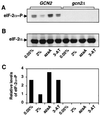
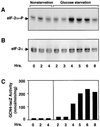


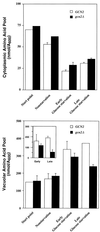
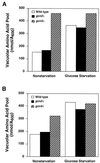

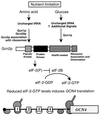
Similar articles
-
Dimerization is required for activation of eIF2 kinase Gcn2 in response to diverse environmental stress conditions.J Biol Chem. 2004 May 28;279(22):22820-32. doi: 10.1074/jbc.M402228200. Epub 2004 Mar 9. J Biol Chem. 2004. PMID: 15010461
-
The histidyl-tRNA synthetase-related sequence in the eIF-2 alpha protein kinase GCN2 interacts with tRNA and is required for activation in response to starvation for different amino acids.Mol Cell Biol. 1995 Aug;15(8):4497-506. doi: 10.1128/MCB.15.8.4497. Mol Cell Biol. 1995. PMID: 7623840 Free PMC article.
-
Histidyl-tRNA synthetase-related sequences in GCN2 protein kinase regulate in vitro phosphorylation of eIF-2.J Biol Chem. 1996 Oct 4;271(40):24989-94. doi: 10.1074/jbc.271.40.24989. J Biol Chem. 1996. PMID: 8798780
-
Gene-specific translational control of the yeast GCN4 gene by phosphorylation of eukaryotic initiation factor 2.Mol Microbiol. 1993 Oct;10(2):215-23. doi: 10.1111/j.1365-2958.1993.tb01947.x. Mol Microbiol. 1993. PMID: 7934812 Review.
-
Regulation of translation initiation by amino acids in eukaryotic cells.Prog Mol Subcell Biol. 2001;26:155-84. doi: 10.1007/978-3-642-56688-2_6. Prog Mol Subcell Biol. 2001. PMID: 11575165 Review.
Cited by
-
Selective control of amino acid metabolism by the GCN2 eIF2 kinase pathway in Saccharomyces cerevisiae.BMC Biochem. 2010 Aug 4;11:29. doi: 10.1186/1471-2091-11-29. BMC Biochem. 2010. PMID: 20684782 Free PMC article.
-
Translational regulation in response to stress in Saccharomyces cerevisiae.Yeast. 2019 Jan;36(1):5-21. doi: 10.1002/yea.3349. Epub 2018 Sep 3. Yeast. 2019. PMID: 30019452 Free PMC article. Review.
-
Loss of translational control in yeast compromised for the major mRNA decay pathway.Mol Cell Biol. 2004 Apr;24(7):2998-3010. doi: 10.1128/MCB.24.7.2998-3010.2004. Mol Cell Biol. 2004. PMID: 15024087 Free PMC article.
-
An unknown essential function of tRNA splicing endonuclease is linked to the integrated stress response and intron debranching.Genetics. 2023 May 26;224(2):iyad044. doi: 10.1093/genetics/iyad044. Genetics. 2023. PMID: 36943791 Free PMC article.
-
Gcn4 is required for the response to peroxide stress in the yeast Saccharomyces cerevisiae.Mol Biol Cell. 2008 Jul;19(7):2995-3007. doi: 10.1091/mbc.e07-11-1173. Epub 2008 Apr 16. Mol Biol Cell. 2008. PMID: 18417611 Free PMC article.
References
-
- Bergmeyer H U, Bernt E, Schmidt F, Stork H. d-Glucose. In: Bergmeyer H U, editor. Methods of enzymatic analysis. Vol. 3. New York, N.Y: Academic Press, Inc.; 1974. pp. 1196–1201.
-
- Berlanga J J, Santoyo J, De Haro C. Characterization of a mammalian homolog of the GCN2 eukaryotic initiation factor 2alpha kinase. Eur J Biochem. 1999;265:754–762. - PubMed
Publication types
MeSH terms
Substances
Grants and funding
LinkOut - more resources
Full Text Sources
Other Literature Sources
Molecular Biology Databases
